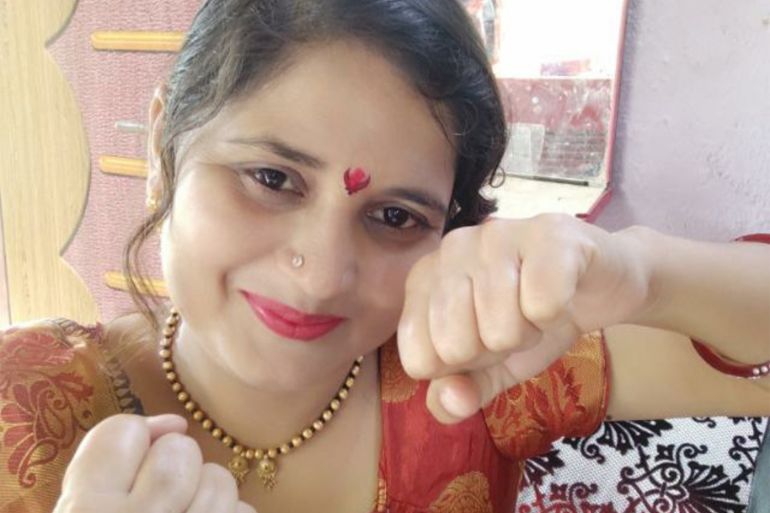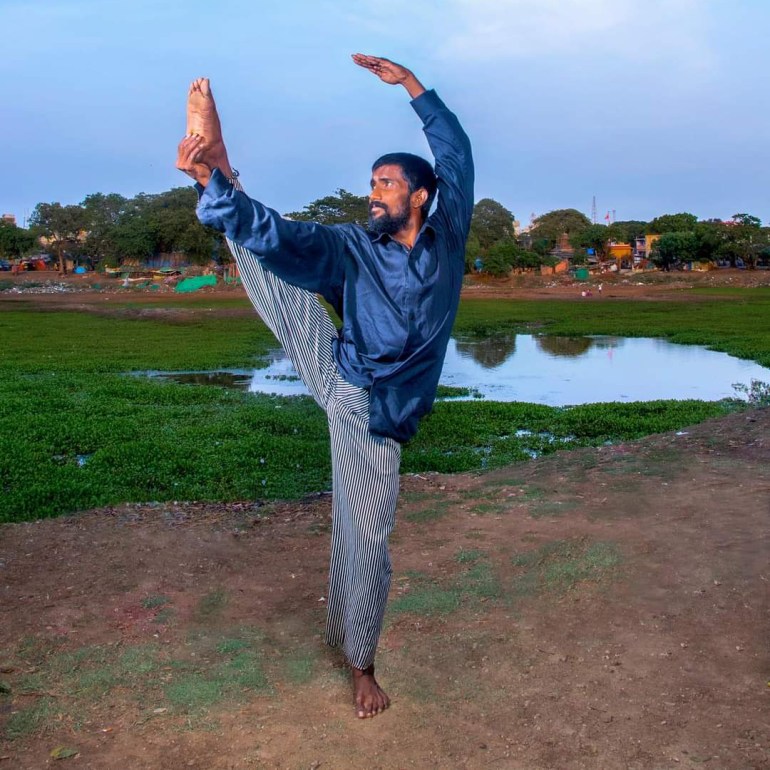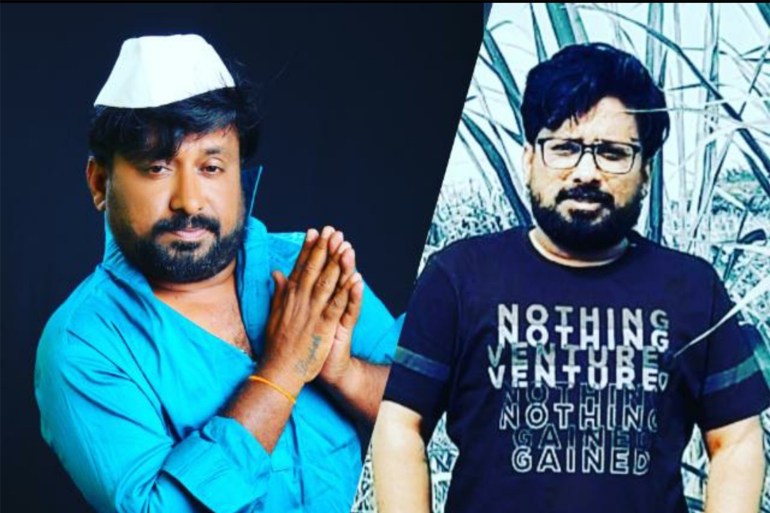India’s ex-TikTok stars ‘feel lost’, ‘forgotten’ a year after ban
The predominantly lower middle class stars lost their limelight exactly how they had earned it: suddenly and unexpectedly.

Mumbai, Maharashtra – When COVID-19 first broke out in India last year, Umesh Gunjal could see his survival hanging by a thread.
The federal government had imposed a nationwide lockdown in March 2020, which forced the 31-year-old to pack up his street food stall in Beed, a decrepit town in western India’s Maharashtra state.
Keep reading
list of 4 itemsIndians from marginalised groups crowdfund for Western education
Attack on Muslim man: India police charge journalists for tweets
Families grapple as India’s health bodies change COVID guidelines
“Nobody could step out of the house,” he told Al Jazeera. “And the stall is my only source of income.”
While figuring out a way to ensure his modest earnings of $300 a month did not disappear entirely, Gunjal had an idea. He put out a message on TikTok, offering to deliver street food at customers’ doorsteps.

Gunjal knew he could depend on the Chinese-owned app, where he had gathered a following of more than 200,000 fans by uploading 15-second videos of himself lip-synching to Bollywood songs with his wife, Pooja, who also had 150,000 followers of her own.
Some of their videos also included slapstick humour, turning them into local celebrities.
“We were covered in newspapers. People recognised us in the streets and asked for selfies. We felt like celebrities,” Gunjal told Al Jazeera.
With most of their following concentrated in Beed, the couple managed to get through last year’s pandemic lockdown because of the orders they received from their fans.
“The first wave had not spread into rural areas, so the two of us could move around a bit, dodging the cops,” Gunjal said.
“It helped keep my family afloat. But more than money, TikTok helped us earn respect in society. We became confident human beings … It wouldn’t have otherwise been possible for street food vendors living in a small town like Beed.”
Community of unlikely stars
Ever since its launch in September 2016, TikTok’s popularity exploded across the globe, leading to an enormous, mystifying but unique community of unlikely stars who shot to fame with their 15-second videos.
The app’s tools were simple to use for those who do not speak or read English or Hindi, and it worked well on low-speed internet.
India soon became TikTok’s biggest international market with 200 million users, most of them coming from marginalised backgrounds that did not have an online platform or any digital access to showcase their talents in a society that remains stratified with caste and class.
TikTok helped thousands of such people gain confidence, experience moments of joy, and earn respect.
But just as TikTok stars such as Gunjal and Pooja, had begun to get used to their stardom, Prime Minister Narendra Modi’s government banned the app, along with 58 others, amid deadly border tensions with China.
The ban was in retaliation to the killing of 20 Indian soldiers and four Chinese troops in hand-to-hand combat on a disputed Himalayan border between the two nuclear powers in June last year.
June 29 this year marks a year of India banning TikTok and other Chinese-owned apps.
Substitutes not the same
In the past year, Gunjal and Pooja were among the TikTok stars who tried to find other substitutes for the popular app.
Facebook-owned Instagram released a TikTok-like Reels feature shortly after India’s ban. And then there were Indigenous Indian apps such as Chingari, Mitron, Roposo, Bolo Indya and others that rushed to capture the void created by the absence of TikTok.
“But it isn’t the same,” Pooja told Al Jazeera. “The crowd that was under one roof of TikTok got divided between several apps. So we no longer get the engagement we used to get.”
For now, the couple has settled for Instagram. But Pooja and Gunjal sometimes feel they do not belong there.
“I have 8,000 followers on it (Instagram) and Umesh has about 20,000. But the crowd on Instagram is different from TikTok,” said Pooja, explaining how TikTok had more people from her socioeconomic background.
“People in Beed, for example, are slowly joining Instagram, but it will take time.”
Arman Rathod, a 29-year-old former TikTok star with 230,000 Instagram followers now concurs with Pooja.
“I would hit a million likes on TikTok in a day,” he told Al Jazeera in a telephone interview from Valsad town in the neighbouring Gujarat state.
“Instagram has also been great over the past year. But I miss TikTok. It has given me everything in life.”

With no work and no outside activity during last year’s lockdown, Rathod downloaded TikTok on his phone “to pass time”.
Little did he know he would soon become a sensation, with celebrities including cricketers David Warner and Irfan Pathan, and singer Honey Singh making videos with him.
‘My career ended just as it took off’
Rathod joined TikTok three months before it was banned and had amassed seven million followers in no time.
“I have always loved to dance. I didn’t have anything to do during the lockdown so I started recording clips of me dancing,” he says. “One of them got 70 million views on TikTok. I couldn’t understand what was going on.”
Rathod, who used to make ends meet by washing cars, said he tried looking for work as a dancer but only received rejections.
“I have struggled a lot,” he says.
“My father is a retired security guard and my mother worked as a domestic help. I didn’t have any contacts in high places or financial security to pursue a career in dancing. Had it not been for TikTok, nobody would have ever noticed me.”
When the Modi government banned TikTok, Rathod was devastated. “It felt like my career ended just as it took off,” he says.
“It was the only platform where I could showcase my dancing skills and get appreciated for it. I had otherwise gotten zero opportunities. I didn’t do anything for a month after the ban. Then I moved to Instagram. I also have a YouTube channel with over 5,000 subscribers.”
Today, Rathod gets requests to promote new songs on various platforms and makes 10 times the amount he did washing cars in Valsad.
“My parents are proud of me,” he says. “Today I get written about, people request selfies with me – it is all because of my parents. Even during our worst days, they never discouraged me. I am happy that I can take care of them while doing what I love.”
‘Felt a little lost since the ban’
However, unlike Rathod, many have struggled to migrate and adjust to other apps after the TikTok ban.
Deepak Ghubade, a 34-year-old sugarcane farmer in Beed, says the alternate apps are not as user friendly as TikTok.
“The lip synching was often a task on the other apps,” he says. “TikTok was simple and uncomplicated. I have felt a little lost since the ban.”

Ghubade always wanted to be an actor but he could not pursue his dreams because it was difficult to leave his farmland in the village, 380km (236 miles) from India’s financial and filmmaking hub, Mumbai.
Farmers in his district of Beed have been struggling with rural distress for the past few years, with many dying by suicide.
“Most of the acting opportunities are in Mumbai,” he says. “I had to manage the farm. I had to look after my family.”
But TikTok allowed him to flirt with his dream.
“I am not a privileged person. But I could bypass a lot of barriers and create content sitting in my village because of TikTok,” says Ghubade. “I didn’t need influential contacts. All I needed was a smartphone.”
At the time of the ban, Ghubade had 75,000 followers on TikTok, keenly watching his passionate dance to regional songs. He said that “respected people” in the district invited him as a chief guest at ceremonies.
But it has not been the same since the ban. Some of the TikTok stars lost their limelight exactly the way they had earned it: suddenly and unexpectedly.
Sangita Gaikwad recently got that unpleasant reminder when she turned 36 on June 1.
From her home in a small cotton-growing village about 100km (62 miles) from Beed, Gaikwad, with at least 100,000 followers on TikTok at the time of the ban, had become a raging sensation in Maharashtra’s Jalna district.
“My daughter insisted I get on TikTok,” Gaikwad told Al Jazeera. “I made one comic video where I am heading to buy meat from the market. That got over 100,000 views.”
Gaikwad, a homemaker, started posting more videos of her cooking or buying meat. Soon, she started being known as the “meat lady” in her locality.
“On my birthday last year, people sent me gifts from all over Maharashtra,” she says. “My phone didn’t stop ringing. They scrambled to make a video with me. This time around, I didn’t even get a cake from anyone.”
Dejected with her depleting fame, Gaikwad held a live session on Instagram, where she has more than 50,000 followers but does not quite get the response she used to.
“It seems like people have forgotten me,” she rued, reminiscing the good old TikTok days.